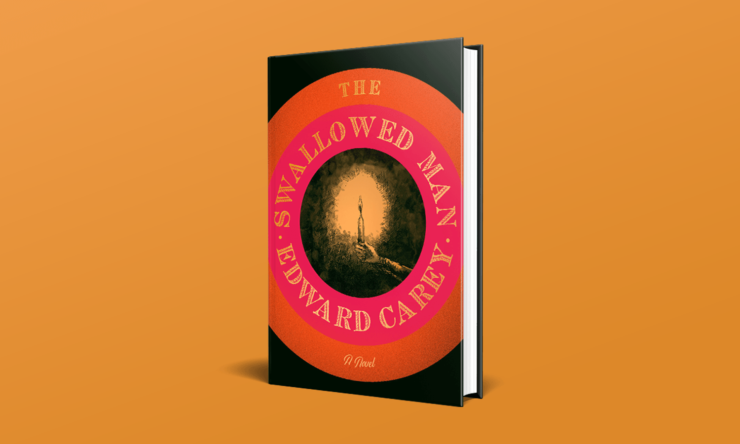I hadn’t expected to see a new Edward Carey novel for a few years yet, but here is The Swallowed Man, just two years after the publication of Little, his big book about the waning and waxing of Madame Tussaud’s fortunes in the French Revolution. That massive novel took fifteen years to write; to receive another book so soon is a pleasant surprise. Little was an epic about the obscure story behind a familiar name; The Swallowed Man, in contrast, is a compact retelling of a familiar story from an obscure perspective.
The story of Pinocchio, as reimagined by Walt Disney in 1940, is famous the world over; the original novel by Carlo Collodi, the pen name of Carlo Lorenzini, whose family came from the Italian town of Collodi, isn’t read much outside of Italy, though translations are available. While the popular animation and its Italian original share much of the same story—the lonely carpenter, the miraculous carving, the good fairy, the fearsome whale, the boys turned to donkeys, the tell-tale nose, etc.—Collodi’s tale perturbs where Disney’s soothes. Gepetto beats his son, for one thing; Pinocchio burns his feet to cinders on his first night alive, for another. In 2018, the Parco di Pinocchio in Collodi commissioned the novelist and artist Edward Carey to create a text, sculptures, and illustrations for an exhibition; now Riverhead has published The Swallowed Man, a revised and expanded edition of the story Carey wrote for the Parco di Pinocchio.
Carey presents his story as the diary of Pinocchio’s “father,” called Gepetto in most adaptations and on the book’s jacket, but who here refers to himself variously as Giuseppe, Joseph, and Josephus. Whatever the narrator deigns to call himself, he writes by candlelight in the cabin of the Maria, the empty Danish ship he discovered in the darkness of the whale that has swallowed him up. The Maria is stocked with candles, preserved food, potable water, and even some bottles of wine. Gepetto has everything he needs to survive, but precious little of what’s necessary to truly live.
Buy the Book


The Swallowed Man
If they didn’t know its origins in the Collodi exhibitions, a reader could be forgiven for imagining The Swallowed Man as the rare happy side effect of coronavirus lockdown. Edward Carey began A Drawing a Day in March 2020 when coronavirus came to the United States; as of this writing, he’s done more than three hundred illustrations. Gepetto, locked down in his makeshift house in the dark of the whale, also turns to art for solace. He’d once performed a miracle, drawing a live boy forth from dead wood, and such a person can never give up creating. The swallowed man discovers that the vanished captain of the ill-fated ship was an amateur painter—Gepetto observes that “his portrait of a fish looks like an old person in distress”—and so the carpenter has an opportunity to create. When the Maria doesn’t provide, he improvises. Gepetto mostly refrains from carving, since the only wood around constitutes his home, but in the course of his sojourn in the whale, his beard hairs become brushes, an unfortunate octopus provides ink, and the ship’s hardtack proves a surprisingly reliable medium for sculpture. Carey has drawn, painted, or sculpted all the objects mentioned in the text, and they are reproduced throughout the book, as are the journal’s water stains, wax splotches, and soot marks.
Gepetto hardly had a chance to be a father to Pinocchio; he drove him away within twenty-four hours of creating him, and in that time referred to the wooden boy as “it,” not as “he.” Love and guilt plague the carpenter in his solitude; his most common subject, sketched in ink, painted in oil, imitated in wood, and even molded in hardtack, is his vanished son. Indeed, Gepetto has only come to the whale’s stomach because he set to sea in search of his lost child. Gepetto wants nothing more than to see his wooden boy again, yet hopes he never will: For who would want their child to be swallowed by a giant whale?
The narrator spends long months and years unmoving in the belly of the beast, but his story moves quickly in terse sentences and short paragraphs. The Pinocchio story is pure fantasy, but we never doubt that a man staving off madness with words would write this way. That said, there are occasional forays into fancifulness; Carey indulges a penchant for alliterative wordplay (“This tome in my tomb”) and for strings of incantatory coinages (“the seabeast, the sharkfort, the whalecastle”; “Woodskin. Woodbones. Woodheart. Woodlife.”). I generally like this sort of thing; others may have less patience.
Carey is an extremely talented writer; if his works were bereft of his illustrations, they would be diminished, but still worth reading. But, as was the case with Little, Carey’s art is essential to his artistic project. The lonely portrait bust decorated with mussels and seaweed is sad, endearing, and a bit sinister, while the many delicately stippled illustrations in graphite and the occasional oils and watercolors would be striking even outside of their literary context. Unfortunately, neither the ebook nor the hardback reproduce any of the images in color; for that, you’ll have to visit Carey’s website.
In his afterword, Carey mentions that the English-language Swallowed Man is substantially longer than the Italian Nel ventre della balena; he kept adding to his story. As I don’t have an Italian edition to check, I can’t be sure what was added, but I have my guesses. There are several extended asides on Gepetto’s early life and on tangential characters, and I wonder if these were always present. The reflections on possible fates for the Maria’s crew and the catalogue of Gepetto’s failed love affairs—including a connection with a sickly preparer of burial niches and an unrequited infatuation for a hallucination brought on by a gas leak!—are poignantly entertaining but distract from the emotional core of the book. I enjoyed reading them, but I’m not sure these darlings should have survived the editor.
I’ve spoken of Carey’s latest as a book well-suited for today, as we lock down and shut in, but to talk only in terms of present circumstances is to do this book a disservice. The Swallowed Man won’t be for everyone, but its proper readers will treasure it for years to come. This is a book of the moment that will be remembered long after these days have passed.
The Swallowed Man is available from Riverhead Books.
Matt Keeley reads too much and watches too many movies. You can find him on Twitter at @mattkeeley.










